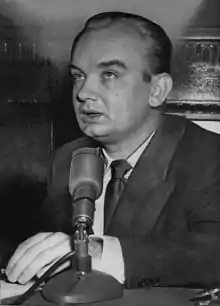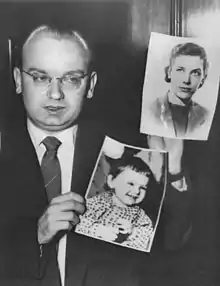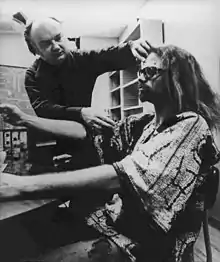Nikolai Khokhlov
Nikolai Evgenievich Khokhlov (Cyrillic: Николай Евгеньевич Хохлов; 7 June 1922 – 17 September 2007) was a KGB officer who defected to the United States in 1954. He testified about KGB activities. The KGB unsuccessfully tried to kill him with poison in 1957.
Nikolai Khokhlov | |
|---|---|
 Khokhlov at U.S. Senate Internal Security Subcommittee in 1954 | |
| Born | 7 June 1922 Nizhny Novgorod, Russia |
| Died | 17 September 2007 (aged 85) |
| Occupation | KGB spy |
Family background

Khokhlov's parents divorced when he was very young. He was not well-acquainted with his father, who later served as a commissar in the Red Army. During the Battle for Moscow, the elder Khokhlov was transferred to a penal battalion because he had made unfavourable remarks about Joseph Stalin. Khokhlov's father died in the battalion.
His stepfather, a lawyer, volunteered to defend Moscow in 1941 and died in action almost immediately. As Khokhlov later put it, "The army needed cannon fodder".[1]
NKVD career
In October 1941, Khokhlov, then 19 years old, was a member of an NKVD quartet who were trained to commit a spectacular attack against Nazi officers during their victory celebration in the occupied Moscow. The mastermind behind the plan was Mikhail Maklyarskiy, a senior NKVD official. The four young agents would have played a vaudeville group on the celebration. Khokhlov was chosen for his role on his whistling abilities. During the training, he had his first great romance with fellow agent, singer Tasya Ignatova. After the German retreat from the outskirts of Moscow, the deadly show was cancelled.[2]
Nikolai Khokhlov was a member of a successful military unit that fought behind the enemy lines during World War II. He was disguised as a Nazi officer after parachuting into German-occupied Belarus. He played a part in the assassination of Wilhelm Kube, the Nazi Gauleiter of Belarus. After the war, Khokhlov became the prototype for the main character in a 1947 Soviet film, Feat of a Scout ("Подвиг разведчика").
Assassination mission
In 1954, Khokhlov was sent by the KGB to supervise two other men whose task was to kill Georgiy Okolovich, a chairman of the National Alliance of Russian Solidarists. He decided not to follow the order and discussed the situation with his wife, Yana, who said, "If this man is killed, you will be a murderer. I cannot be the wife of a murderer."[3] Khokhlov went to Okolovich's flat in Frankfurt and told him: "Georgiy Sergeyevich, I have come to you from Moscow. The Central Committee of the Communist Party of the Soviet Union has ordered your assassination. The murder is entrusted to my group... I can’t let this murder happen."[4] In retaliation, his wife was arrested and sentenced to five years of involuntary settlement in the Soviet Union. Khokhlov defected to the United States following his failure to carry out the assassination order.
Poisoning by thallium
Khokhlov was treated for thallium poisoning in Frankfurt in 1957,[5] as a result of a failed assassination attempt by the Thirteenth Department of the KGB.[4] This case is often claimed to be the first radiological attack by the KGB, especially when comparison with the poisoning of Alexander Litvinenko[6][7] is drawn, although it remains unclear what isotope was used, if any.[8] Former KGB officer Stanislav Lekarev claimed, however, that Khokhlov was poisoned by radioactive polonium (not thallium), exactly as Litvinenko was.[9] Litvinenko's poisoning was also initially mistaken for thallium.
Life in the United States

After graduating with a PhD from Duke University, Khokhlov taught undergraduate and graduate psychology classes at California State University, San Bernardino from 1968 to 1992. He retired as a professor emeritus in 1993. In 1992, Russian President Boris Yeltsin pardoned him. The same year Khokhlov returned to Moscow for a short stay, for the first time since the 1950s.[10] He later made an e-mail contact with, then eventually met, his son in Russia of whom he had not been previously aware. In the United States, Khokhlov married again. With his second wife Tanya, he had two daughters and a son, Misha, who died several years later due to a kidney failure.[11]
In 2006, Khokhlov compared his poisoning half a century ago to the murder of Litvinenko. "The situation within Russia today is very perilous. There are no more laws, and no more order. Putin brought back many KGB, and there are too many KGB at the top, the old dinosaurs who cannot get rid of old habits", he added.
Nikolai Khokhlov died of a heart attack in San Bernardino, California, in September 2007. He was buried next to the grave of his son.
See also
- Alexander Litvinenko poisoning
- List of Eastern Bloc defectors
References
- Andrew Nagorski (2007) The Greatest Battle. Simon and Schuster. pp. 198–199. ISBN 9781416545736
- Andrew Nagorski (2007) The Greatest Battle. Simon and Schuster. pp. 196–198. ISBN 9781416545736
- The spy poisoned by the KGB – but who lived to tell the tale. Times Online. 1 December 2006.
-
- Christopher Andrew and Vasili Mitrokhin (2000) The Mitrokhin Archive: The KGB in Europe and the West, Gardners Books. ISBN 0-14-028487-7
- "Meeting with past (Russian)". Archived from the original on 27 July 2006. Retrieved 19 November 2006.
- Alex Goldfarb and Marina Litvinenko (2007) of a Dissident: The Poisoning of Alexander Litvinenko and the Return of the KGB, The Free Press. ISBN 1-4165-5165-4
- Boris Volodarsky (2009) The KGB's Poison Factory: From Lenin to Litvinenko . London/Barnsley : Frontline Books. pp. 166–81; ISBN 978-1-84832542-5. (English)
- "Category: Radiation Basics". Archived from the original on 19 October 2007. Retrieved 3 April 2008.
- Who Killed Litvinenko? – Russia on YouTube
- Николай Евгеньевич ХОХЛОВ. belousenko.com
- Volchek, Dmitri (4 June 2009) ость радиожурнала Поверх барьеров – историк спецслужб Борис Володарский. svoboda.org
Books
- Nikolai Evgenievich Khokhlov. In the name of conscience . Translated by Emily Kingsbery. New York : David McKay, 1959. In the name of conscience (Russian)
- Boris Volodarsky. Nikolai Khokhlov ("Whistler"), Self-Esteem with a Halo . Vienna-London : Borwall Verlag, 2005. (English)
External links
| Wikimedia Commons has media related to Nikolai Khokhlov. |
- Obituary
- A brief history of Soviet torturers and assassins, some of whom had second thoughts. By Katya Drozdova, Hoover Institute
- Newspaper Article: Times Online
- I led KGB hit squad by Ros Wynne Jones
- One more time on the Alexander Litvinenko case by Vadim Birstein
- Interview to Radio Free Europe